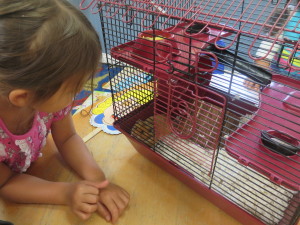Benefits of Classroom Pets
Whether it’s Math (“how much does a hamster weigh?”) or Science, (“what does a snake eat?”) Geography (“what part of the world do ferrets come from?”) or Grammar (“what words would we use to describe a goldfish?”) students will approach learning all these subjects with a new enthusiasm and interest.
Pets Enrich the Classroom Experience
• Even kids with no exposure to animals or nature in their home environment can see, feel, touch and make connections to the wide world of animals.
• Observing and caring for an animal instills a sense of responsibility and respect for life.
• A pet brings increased sensitivity and awareness of the feelings and needs of others—both animals and humans.
• Kids learn that all living things need more than just food and water for survival.
• Students will see directly how their behavior and actions affect others.
• Studies show that the presence of animals tends to lessen tension in the classroom.
Welfare
“Being around animals is extremely good for children”, says Dr. Harvey Markovitch, pediatrician and editor of The Archives of Disease in Childhood. “They’re good for morale, and teach children about relationships and about the needs of another living being – learning to care for a pet helps them to learn how to care for people”. Studies show caring for pets aids in improving school attendance and teaching children about responsibility.
Pets Build Self Esteem
Helping to take care of a pet gives a child a sense of pride and accomplishment, especially if the animal is able to return the affection. Shari Young Kuchenbecker, Ph.D., research psychologist at Loyola Marymount University in Los Angeles, says, “The child who cares for a pet knows that what he does matters, and so he’ll want to do more of it. The more successfully he feeds, walks, or emotionally bonds with the pet, the more confident he’ll feel.” In fact, studies conducted by the Waltham Centre have shown that children with pets have higher levels of self-esteem than those without pets.
Pets Teach Responsibility
Even a small child can begin to learn to care for the needs of another living being. Whether helping to empty a cup of dry kibble into the rabbit’s bowl, or filling the hamster’s water bottle, it’s never too early to start teaching kids proper animal care.
Pets Become Friends
Lots of animals such as cats, dogs and guinea pigs love human contact and can become a child’s best buddy. Kids can even develop strong human animal bonds with non-responsive animals such as fish or turtles. These relationships help to strengthen a child’s social skills, giving them the potential to do better in a school setting.
______________________________________________________________
 ” Kristin Rude is the Owner and Center Director of FasTracKids, Del Mar, established in 2007. She started teaching Kindergarten in 1992. Kristin last taught in the Del Mar Union School District. She obtained her teaching credential from the University of San Diego and has her Masters degree in curriculum and instruction with an emphasis on second language learners. When Kristin is not working, motherhood keeps her plenty busy with her 2 children, Connor, age 5 & Katherine, age 4. It has been a truly rewarding experience watching her own children benefit from the FasTracKids program. Spending time with her family, golfing, traveling, and continuously learning are among her favorite activities.”
” Kristin Rude is the Owner and Center Director of FasTracKids, Del Mar, established in 2007. She started teaching Kindergarten in 1992. Kristin last taught in the Del Mar Union School District. She obtained her teaching credential from the University of San Diego and has her Masters degree in curriculum and instruction with an emphasis on second language learners. When Kristin is not working, motherhood keeps her plenty busy with her 2 children, Connor, age 5 & Katherine, age 4. It has been a truly rewarding experience watching her own children benefit from the FasTracKids program. Spending time with her family, golfing, traveling, and continuously learning are among her favorite activities.”











You must be logged in to post a comment Login